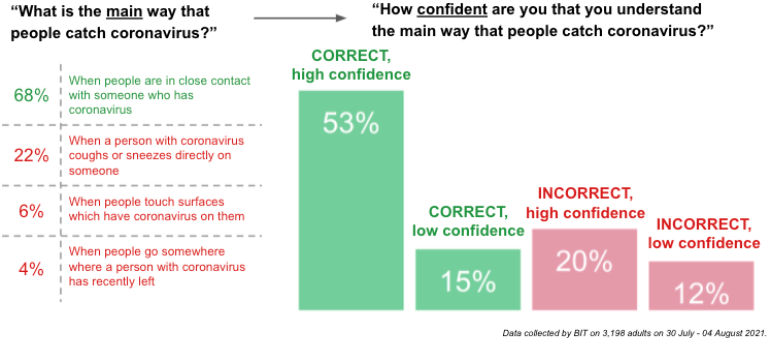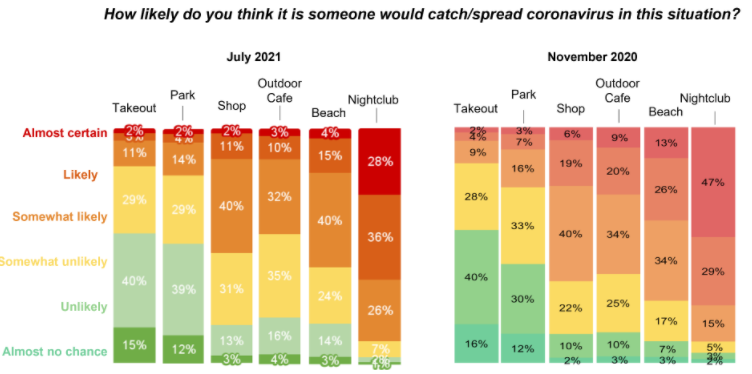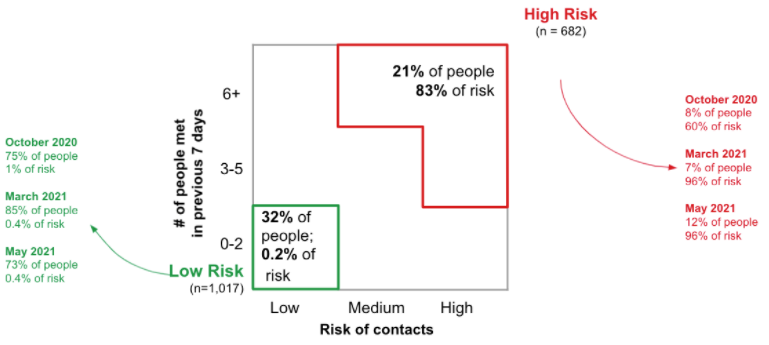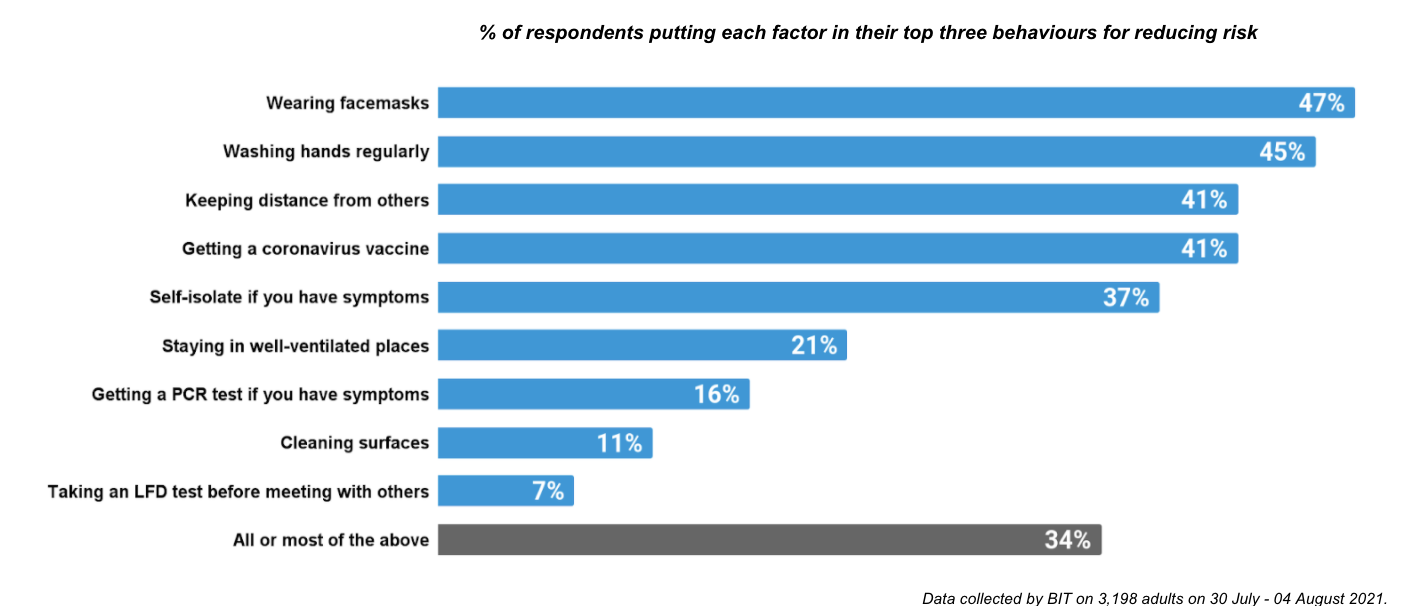On ‘Freedom Day’ (July 19th 2021) England entered a new phase in its approach to managing coronavirus. Instead of legislation mandating behaviours, guidance will help people use their own judgement to make risk-based decisions.
This change means it is especially important for policymakers to understand how people think about coronavirus risk. Our hypothesis is that people’s understanding of the way the virus transmits is key. If someone knows, for example, that coronavirus can be airborne and spreads well in poorly ventilated places, they are probably going to stick to socialising outdoors. This information will help policy makers to focus efforts on the areas that can maximise impact.
Over two blogs, we’ll share findings from an online experiment we conducted over the summer with 〜3,200 adults in England. In part one, we’ll examine how people understand coronavirus risk. In part two, we’ll look at factors that affect risk perception and explore approaches to make more accurate risk assessments.
So, here are three key findings that can help us understand how people perceive coronavirus risk.
1. A sizable minority are still unable to name the main way that coronavirus spreads. Many continue to overestimate the importance of hand-washing.
We know that coronavirus spreads best in poorly ventilated, crowded indoor spaces. Over the course of the pandemic, the evidence has built up that this is in large part because the virus can transmit through the air, like scent. Government guidance has recently begun to emphasise this by focusing on the importance of fresh air and ventilation to control the spread.
However, when we asked people to identify the main way people catch coronavirus, 1 in 3 people failed to identify that close contact is the primary transmission route.

This may partly result from the emphasis early in the pandemic on the importance of handwashing when transmission was thought to primarily come from surfaces.
The stickiness of messaging on handwashing may explain why we found it was slightly more likely than vaccination to be in people’s top 3. Most worryingly, it was twice as likely as staying in well ventilated spaces – one of the most important protective measures. Other studies have found similar results: people are more likely to say cleaning hands or surfaces is very effective despite coronavirus being an airborne virus.
2. People have a good sense of which social situations are riskier than others. In absolute terms people think their risk of catching coronavirus is much lower than it was last year.
We asked people to rate how likely someone would be to catch or spread coronavirus in a range of different scenarios. The responses indicate that people have a good sense of which activities were riskier than others. For example, people rated parks as safer than nightclubs and takeaways as safer than cafes.

November 2020, 47% of people thought that the risk of someone catching or spreading coronavirus in a nightclub was almost certain. In this experiment, only 28% thought so. Whilst positive cases were higher this summer than last autumn, the low death rate and vaccination campaign may mean people had a lower perception of risk.
3. The potential risk of catching or spreading coronavirus is unevenly distributed.
To understand how the risk of catching or spreading coronavirus is distributed in the population, we used a weighted model to measure transmission risk. It combines the number of contacts an individual had in the previous week with the riskiness of the situations in which they met. For example, meeting indoors is 10 times riskier than outdoors, whilst meeting for 30 minutes is 5 times riskier than for 10 minutes. Those in the high risk group are people who meet 3 or more people, without safety precautions (e.g. no masks etc).*

In October 2020, we found that around 1 in 12 people were considered at high risk of transmitting or catching coronavirus and accounted for 60% of the total transmission risk. This summer, around 1 in 5 people are high risk and account for 83% of transmission risk. It’s no surprise that the proportion has increased as restrictions have eased. People in this group are more likely to be unvaccinated, less worried about coronavirus, have low trust in the government and be younger.
Takeaways and our next blog
Our research indicates that we need to improve understanding of transmission in order to help people make informed risk judgments. The UK government’s emphasis on fresh air and ventilation is already playing a key part in this. We also need to explore ways to improve risk perception among the growing number of potential superspreaders. At the same time, we need to support those who are “strong compliers”, potentially overly worried about coronavirus, to engage safely in society. In our next blog, we’ll explore some of the approaches we tested to do exactly that.
*One caveat to this model: these are rough weightings, based on our understanding of the best available evidence on coronavirus transmission risk, but they are subjective and could reasonably be challenged. For example, we only include social contacts, not work contacts when we know transmission occurs in the workplace. We have assumed that double vaccination status reduces 20% of the baseline risk. To identify those with high risk of spreading or catching coronavirus, we weighted strongly the number of social contacts they had. However, as the percentage of double vaccinated individuals increases in the population, this factor might decrease in importance over time.







